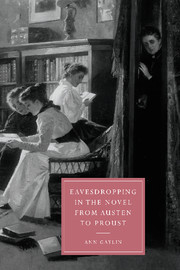Book contents
- Frontmatter
- Contents
- Acknowledgments
- Introduction
- 1 I'm all ears: Pride and Prejudice, or the story behind the story
- 2 Eavesdropping and the gentle art of Persuasion
- 3 Household words: Balzac's and Dickens's domestic spaces
- 4 The madwoman outside the attic: eavesdropping and narrative agency in The Woman in White
- 5 La double entente: eavesdropping and identity in A la recherche du temps perdu
- Conclusion: covert listeners and secret agents
- Notes
- Select bibliography
- Index
4 - The madwoman outside the attic: eavesdropping and narrative agency in The Woman in White
Published online by Cambridge University Press: 22 September 2009
- Frontmatter
- Contents
- Acknowledgments
- Introduction
- 1 I'm all ears: Pride and Prejudice, or the story behind the story
- 2 Eavesdropping and the gentle art of Persuasion
- 3 Household words: Balzac's and Dickens's domestic spaces
- 4 The madwoman outside the attic: eavesdropping and narrative agency in The Woman in White
- 5 La double entente: eavesdropping and identity in A la recherche du temps perdu
- Conclusion: covert listeners and secret agents
- Notes
- Select bibliography
- Index
Summary
The hiding of a crime, or the detection of a crime, what is it? A trial of skill between the police on one side, and the individual on the other. When the criminal is a brutal, ignorant fool, the police in nine cases out of ten win. When the criminal is a resolute, educated, highly-intelligent man, the police in nine cases out of ten lose. If the police win, you generally hear all about it. If the police lose, you generally hear nothing. And on this tottering foundation you build up your comfortable moral maxim that Crime causes its own detection! Yes – all the crime you know of. And what of the rest?
The Woman in WhiteFrederick Walker's poster for the Olympic Theatre's 1871 dramatic adaptation of The Woman in White portrays a woman clothed in white passing through a doorway or large, shuttered window (Figure 1). The background's dark, starlit sky and the woman's frightened glance evoke a nighttime setting of mystery and suspense. The woodcut could represent any of several women in Collins's 1860 novel The Woman in White: the first woman in white whom Walter Hartright encounters, later identified as Anne Catherick; Laura Fairlie, who, dressed in white on the first evening of Walter's stay at Limmeridge House, possesses an uncanny resemblance to Anne; or, as the black-and-white print suggests, a reversed image of Marian Halcombe as she embarks on her aural surveillance mission in the middle of the narrative.
- Type
- Chapter
- Information
- Eavesdropping in the Novel from Austen to Proust , pp. 113 - 138Publisher: Cambridge University PressPrint publication year: 2003

